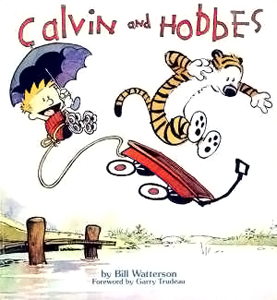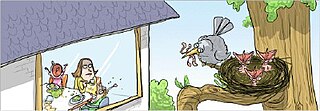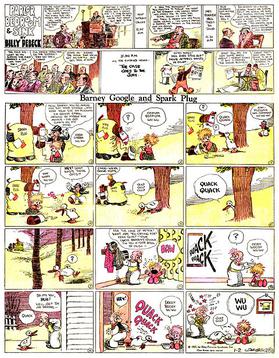
William Boyd Watterson II is an American cartoonist who authored the comic strip Calvin and Hobbes. The strip was syndicated from 1985 to 1995. Watterson concluded Calvin and Hobbes with a short statement to newspaper editors and his readers that he felt he had achieved all he could in the medium. Watterson is known for his negative views on comic syndication and licensing, his efforts to expand and elevate the newspaper comic as an art form, and his move back into private life after Calvin and Hobbes ended. Watterson was born in Washington, D.C., and grew up in Chagrin Falls, Ohio. The suburban Midwestern United States setting of Ohio was part of the inspiration for Calvin and Hobbes. Watterson lives in Cleveland Heights as of January 2024.
A comic strip is a sequence of cartoons, arranged in interrelated panels to display brief humor or form a narrative, often serialized, with text in balloons and captions. Traditionally, throughout the 20th and into the 21st century, these have been published in newspapers and magazines, with daily horizontal strips printed in black-and-white in newspapers, while Sunday papers offered longer sequences in special color comics sections. With the advent of the internet, online comic strips began to appear as webcomics.

Calvin and Hobbes is a daily American comic strip created by cartoonist Bill Watterson that was syndicated from November 18, 1985, to December 31, 1995. Commonly described as "the last great newspaper comic", Calvin and Hobbes has enjoyed broad and enduring popularity, influence, and academic and philosophical interest.

The Far Side is a single-panel comic created by Gary Larson and syndicated by Chronicle Features and then Universal Press Syndicate, which ran from December 31, 1979, to January 1, 1995. Its surrealistic humor is often based on uncomfortable social situations, improbable events, an anthropomorphic view of the world, logical fallacies, impending bizarre disasters, references to proverbs, or the search for meaning in life. Larson's frequent use of animals and nature in the comic is popularly attributed to his background in biology. The Far Side was ultimately carried by more than 1,900 daily newspapers, translated into 17 languages, and collected into calendars, greeting cards, and 23 compilation books, and reruns are still carried in many newspapers. After a 25-year hiatus, in July 2020 Larson began drawing new Far Side strips offered through the comic's official website.
Tom the Dancing Bug is a weekly satirical comic strip by cartoonist and political commentator Ruben Bolling that covers mostly US current events from a liberal point of view. Tom the Dancing Bug won the 2002, 2003, 2007, 2008, and 2009 Association of Alternative Newsweeklies Awards for Best Cartoon. The strip was awarded the 2010 Sigma Delta Chi Award for editorial cartooning by the Society of Professional Journalists and best cartoon in the 2018 Robert F. Kennedy Book & Journalism Awards. His work on the strip won Bolling the 2017 Herblock Prize and the 2021 Berryman Award for Editorial Cartoons, and he was a finalist in the Editorial Cartooning category for the 2019 and 2021 Pulitzer Prize.

The Family Circus is a syndicated comic strip created by cartoonist Bil Keane and, since Keane's death in 2011, is written, inked and rendered (colored) by his son Jeff Keane. The strip generally uses a single captioned panel with a round border, hence the original name of the series, which was changed following objections from the magazine Family Circle. The series debuted on February 29, 1960 and has been in continuous production ever since. According to publisher King Features Syndicate, it is the most widely syndicated cartoon panel in the world, appearing in 1,500 newspapers. Compilations of Family Circus comic strips have sold more than 13 million copies worldwide.

Non Sequitur is a comic strip created by Wiley Miller starting February 16, 1992 and syndicated by Andrews McMeel Syndication to over 700 newspapers. It is also published on gocomics.com and distributed via email.

Diesel Sweeties is known as a webcomic and former newspaper comic strip written by Richard Stevens III. The comic began in 2000, originally hosted at robotstories.com. From January 2007 until August 2008 it was syndicated to over 20 United States newspapers, including major daily newspapers like The Detroit News and Houston Chronicle.
A gag cartoon is most often a single-panel cartoon, usually including a caption beneath the drawing. In some cases, dialogue may appear in speech balloons, following the common convention of comic strips. A pantomime cartoon carries no caption.

Over the Hedge is an American syndicated comic strip, written by Michael Fry, and drawn by T. Lewis. It tells the story of a raccoon, a turtle, a squirrel, and their friends, who come to terms with their woodlands being taken over, by suburbia, trying to survive the increasing flow of humanity and technology while becoming enticed by it at the same time. The strip debuted June 12, 1995.

WUMO, formerly Wulffmorgenthaler, is a webcomic and newspaper comic strip created by Danish writer/artist duo Mikael Wulff and Anders Morgenthaler. The name of the strip is a portmanteau created from the pair's surnames. The name was also given to a comedy TV series, broadcast on the Danish channel DR2 in 2005. The strip changed its name to WUMO in June 2012.

The Sunday comics or Sunday strip is the comic strip section carried in most western newspapers. Compared to weekday comics, Sunday comics tend to be full pages and are in color. Many newspaper readers called this section the Sunday funnies, the funny papers or simply the funnies.

Pooch Café is a Canadian-American gag-a-day comic strip written and illustrated by Paul Gilligan. It was also made into a series of online shorts with RingTales.
Bill Watterson's comic strip Calvin and Hobbes features a wide range of secondary characters. These range from Calvin's fellow students at school to monsters and aliens from Calvin's vivid imagination.
Brewster Rockit: Space Guy! is a satirical retro-futuristic comic strip created by Tim Rickard. It chronicles the misadventures of the dim-witted Brewster Rockit, captain of the space station R.U. Sirius, and his crew. Many of the comic's characters and elements are derived from the Star Trek franchise, American science fiction films of the 1950s, and science fiction comics of the 1940s and 1950s. It debuted on July 5, 2004, and is nationally syndicated by Tribune Content Agency.

Mark Tatulli is an American cartoonist, writer, animator and television producer, known for his strips Liō and Heart of the City and for his work on the cable reality television series Trading Spaces and A Wedding Story, for which he has won three Emmy Awards. His comics have appeared in hundreds of newspapers around the world.

Heart of the City is a comic strip created by Mark Tatulli and currently drawn by Christina "Steenz" Stewart that began syndication by Universal Press Syndicate on November 23, 1998. It is currently syndicated by the Newspaper Enterprise Association.
Barkeater Lake is a webcomic by cartoonist Corey Pandolph, originally published by United Media as part of its Comics.com website from early 2004 through January 5, 2007. Pandolph began publishing the online strip independently on January 22, 2007.

Andrews McMeel Syndication is an American content syndicate which provides syndication in print, online and on mobile devices for a number of lifestyle and opinion columns, comic strips and cartoons and various other content. Some of its best-known products include Dear Abby, Doonesbury, Ziggy, Garfield, Ann Coulter, Richard Roeper and News of the Weird. A subsidiary of Andrews McMeel Universal, it is headquartered in Kansas City, Missouri. It was formed in 2009 and renamed in January 2017.
Bozo is the first pantomime-style comic strip, was created by the cartoonist Francis X. Reardon, who penned it beginning from 1921, until his death in 1955. Bozo is called America's original pantomime comic strip. Bozo ran both as a daily comic strip as well as on Sundays.













